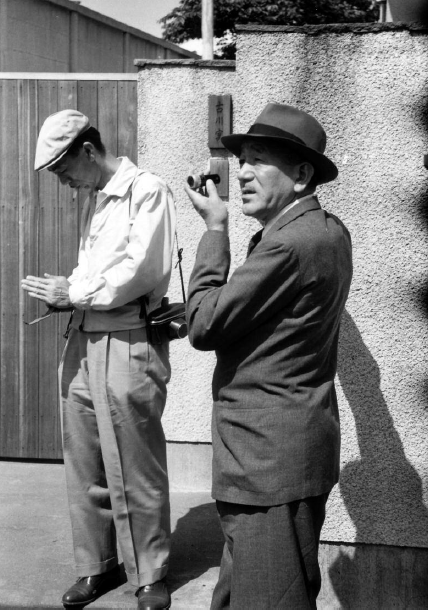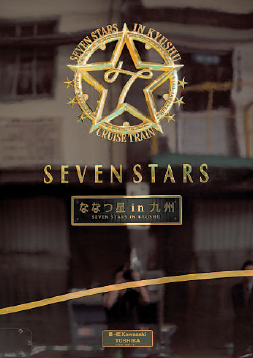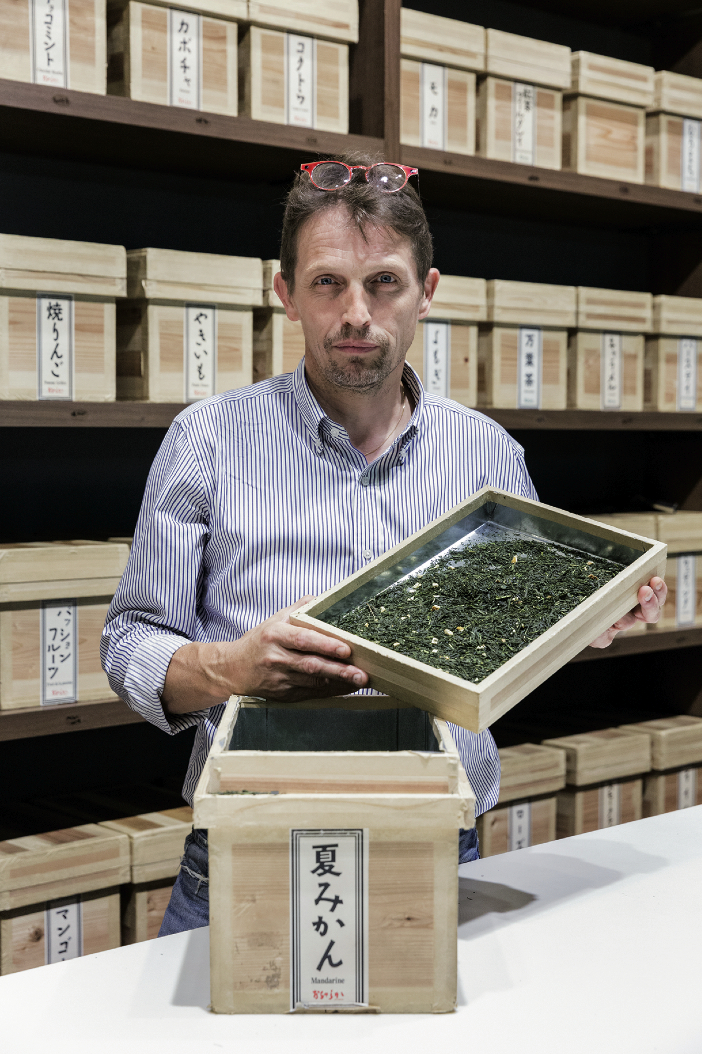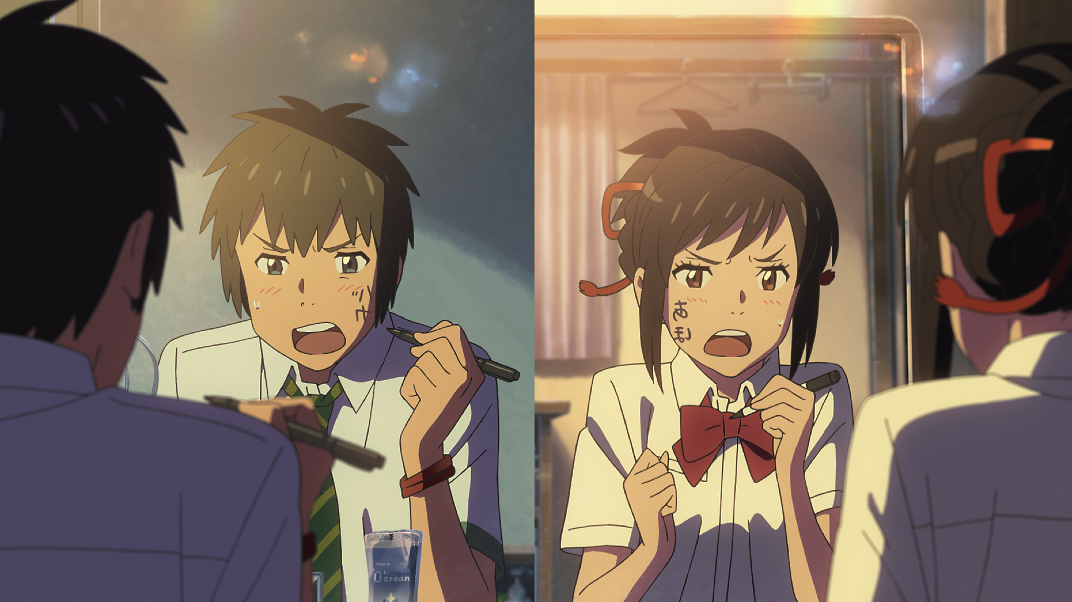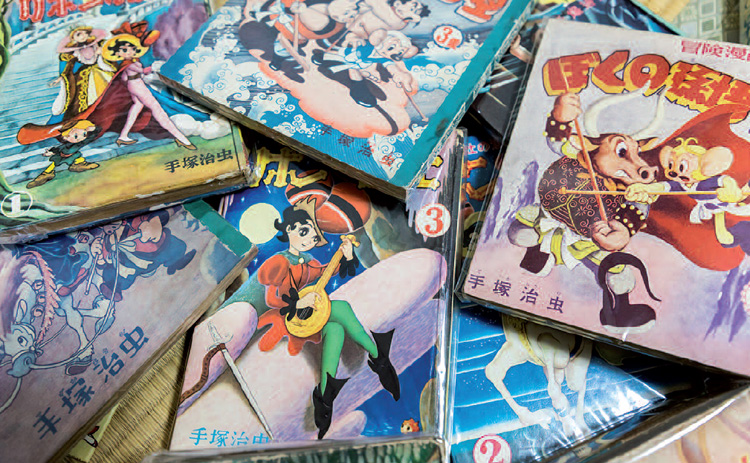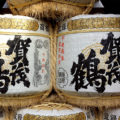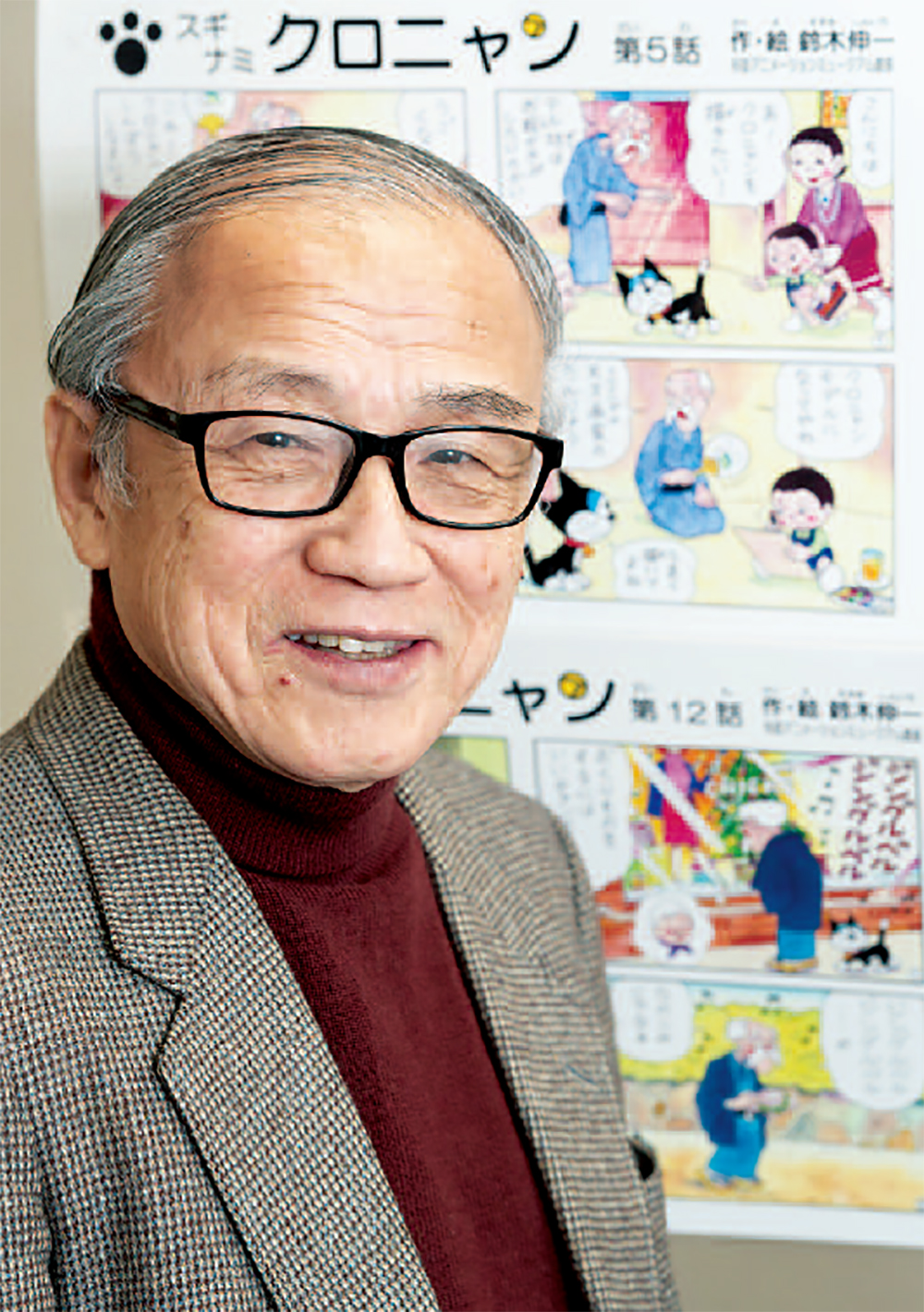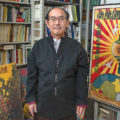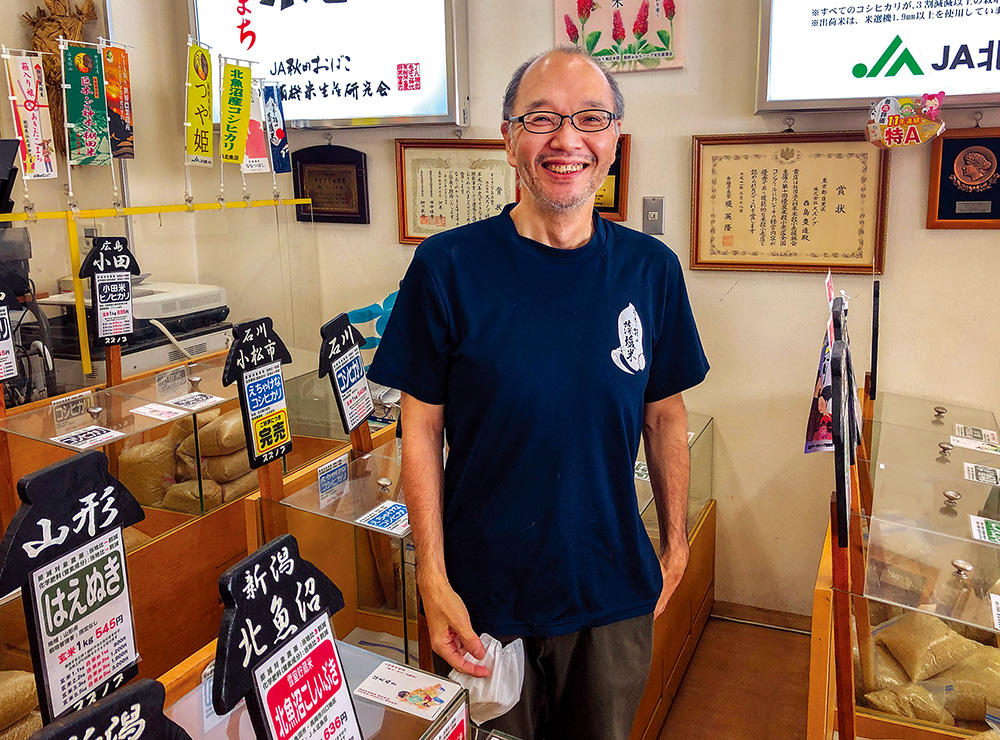

Nishijima Toyozo promotes rice as a way to avoid the decline of the country.
Considered the country’s leading expert on rice, the owner of Suzunobu is unremittingly enthusiastic about it.
Nishijima Toyozo is arguably the best known Japanese expert on all things rice-related.
After graduating from Kitasato University’s Faculty of Veterinary and Animal Husbandry, Nishijima worked for the Hokkaido Agricultural Modernisation Consultancy (currently called the Hokkaido Agricultural Modernisation Technology Centre) until 1988 when he took over his family business, the Suzunobu Shoten rice store. Currently, his shop handles more than 100 brands of rice.
Nishijima has used his knowledge in “agricultural engineering” and the experience acquired while visiting the rice-producing areas in Hokkaido to become a well-respected rice sommelier with a loyal following of rice aficionados. Besides being a lecturer in the Japanese cookery department of a cookery school, he helps farmers improve rice varieties, participates in regional revitalisation programmes, and is often featured in newspapers, magazines, and TV and radio programmes.
Though now working in the retail industry, Nishijima is not afraid of applying his expertise to different areas of his work. “In Hokkaido, I worked on paddy field design and structural calculations for dams,” he says. “At that time, I never thought that the knowledge I gained at university or work could be applied to a rice shop, but it actually proved very useful. Learning about soil and gaining knowledge about agricultural civil engineering is one of my strengths now.
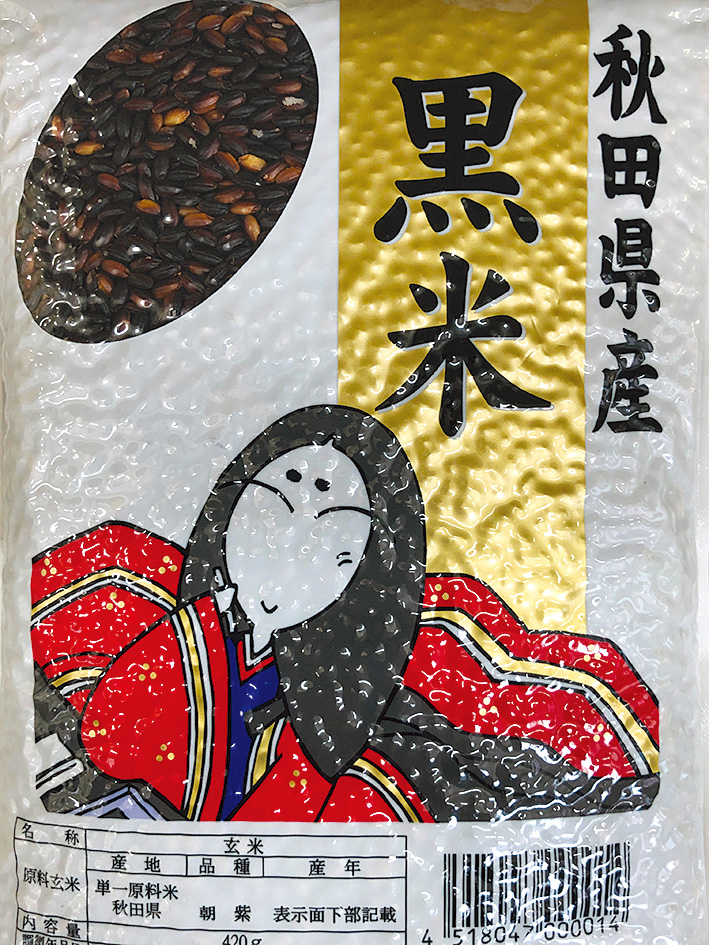
Kuromai (black rice) from Akita.
“For some time, independent retailers have been selling rice that they particularly like by purchasing directly from the producers in order to stand out from the supermarkets. When I took over the store, I visited different regions for that purpose, but before that, I also wanted to study rice varieties and production. However, while looking around the country, I was shocked to see the shortage of young people willing to take over from their fathers, and the bleak state of the rice fields.”
When regional towns go into decline, jobs disappear and houses are left to rot. In such conditions, young people and families have no choice but to move to a bigger city, further accelerating that region’s decline.
According to Nishijima, in order to stop this negative trend, we need to regenerate these places to make them attractive again. “When you grow rice you are at the mercy of nature,” he says. “One year you may have plenty of rice, a year later the harvest will be poor. Then, of course, there are natural disasters such as torrential rain. So I wondered if I could convey the joys and hardships of rice-growing to consumers, to give them a more intimate and tangible relationship with rice production.” Nishijima’s wide-ranging activities not only include connecting with producers but also the JA Group [ Japan Agricultural Cooperatives, a national group of 562 regional co-ops that supply members with information and advice about production, packaging, transportation, the marketing of agricultural products, and provide financial services across the whole region] across the whole region. “We created a brand that can only be produced in that region, like wine,” he says. “Producers, regional agricultural cooperatives, other municipalities, prefectures, and rice retail outlets work together to create new types of rice that are suitable today by developing new cultivation methods and new ideas about how to brand rice. In addition, we will try to revitalise rice production by training people to succeed the many farmers who are now getting too old to continue to work. To that end, we have launched our own project, exploring rice cultivation methods that take advantage of the environment of each region, and creating new rice varieties with unique characteristics and taste.”
Nishijima says he never goes on holiday as he’s constantly travelling to different regions around the country. “Since, as a retailer, I have direct contact with many consumers and understand the business side of rice-growing, I am often asked to give advice. On the other hand, I don’t get as much information back as I would like, especially from the many local farmers who pride themselves on doing everything themselves, from production to distribution. They keep saying, “The rice I grow is the best”. It may be true, but they’re living in the past. The days when individuals could do everything are over. Now’s the time when the entire region must work as one. That’s why we must revitalise community-based agricultural cooperatives.”
The price of Japanese rice is kept high by the fact that most farms are relatively small. “I don’t think large-scale agriculture is possible in Japan as it’s a mostly mountainous country,” he says. “Our prices can’t compete with foreign brands because costs can’t be reduced. What happens is that more and more people are giving up on agriculture, and that is causing the gradual collapse of our farming economy. Agricultural land is being abandoned bit by bit, particularly in tougher places such as mountainous areas. Not only do unmaintained paddy fields dry out, the soil cracks due to the growth of trees and wild plants, and they lose their function as dams that store water. As a result, when it rains heavily, it’s easy for rainwater to flow into the cracks, causing disastrous landslides. When that happens, you’ll lose fertile soil and the precious farmland you’ve built up over decades, making it nearly impossible to revive it. I think it’s time to rethink what farmland is and what rice means to the Japanese.”
Rice has been Japan’s staple food since ancient times, and according to Nishijima, it’s best suited to Japanese stomachs. “Throughout the centuries, our intestines have adapted to digest and absorb rice,” he says. “However, the food market in Japan has diversified to the point that shops and supermarkets have been flooded with food from other cultures. This, of course, is not a bad thing in itself. However, for economic reasons, there are more and more households where both the husband and the wife work, so they often eat out or buy ready-made meals from the supermarket or the convenience store on their way home from work.
The truth is that during a three-meal day, an increasing number of Japanese do not eat rice even once. In other words, the rice culture is at risk of disappearing. That’s why I urge people to cook rice again. Eating rice means eating the kind of healthy food that best suits us. It’s no exaggeration to say that cooking rice at home will preserve Japanese cuisine.
“For us to live a healthy life, we need enough energy for our activities, and for that reason it’s important to have a well-balanced diet centred on our staple food with healthy side dishes such as grilled fish, natto (fermented soybeans), miso soup, steamed dishes, and pickles. They all go well with rice. Even when you’re full, your stomach feels less heavy.
“Rice is an additive-free food. Rice is not a processed product but the raw material itself, and you only need water to cook it. On the other hand, bread uses margarine, sugar, salt, etc., and bread sold at supermarkets contains additives such as emulsifiers, sodium acetate, sweeteners and spices. Also, bread is generally eaten with meat, ham and eggs, bacon, milk, and salad. All this food is overwhelmingly rich in fat. Therefore, if you choose rice, you’ll create more opportunities to eat foods such as fish, soy products, fermented foods, and seaweed. One more thing: if you want to simply enjoy the taste of carefully selected rice, just sprinkle it with salt.
“We are living in a time when everybody seems to be busy and has little time to cook at home. However, home is where children first taste different kinds of food. If they don’t eat good rice during those formative years, they’ll probably always have a negative image of it, even when they grow up. That’s why I always insist that older people play a role in introducing tasty rice to their grandchildren. After all, the older generation has cooked rice all their lives and do it best. They know all the secrets. For example, once the rice is ready, it cannot be kept warm in the rice cooker. Well-cooked rice is sweeter and tastier when it’s eaten as soon as it’s ready. If you keep it warm, the taste deteriorates and the rice disintegrates and becomes sticky. So as soon as the rice cooker indicates that the rice is ready, open the lid and use your shamoji (large flat rice paddle) to gently mix it. And if you can’t eat all the rice in a day, keep what is leftover in the freezer.”
Speaking of cooking, according to Nishijima, water is the one thing that most affects the quality of your eating experience. “Water is the only ‘seasoning’ you need,” he says. I’m always on the lookout for a good water purifier because water is so important to make rice that tastes good. Rice and water are inseparable from each other, but they are hard to combine. You can have the most delicious rice, but if the water quality is bad, no matter how good the rice is, the result will be unsatisfying.
“For a long time, water purifiers were far from ideal. Depending on the kind of water you use (e.g. alkaline or electrolysed, with added minerals or other stuff ), the way rice is cooked will be completely different. The problem with rice is that there are no standard rules to follow. In order to evaluate rice on our website, we cook one brand once every two days for a taste comparison, but if the conditions are not constant, the results become skewed.
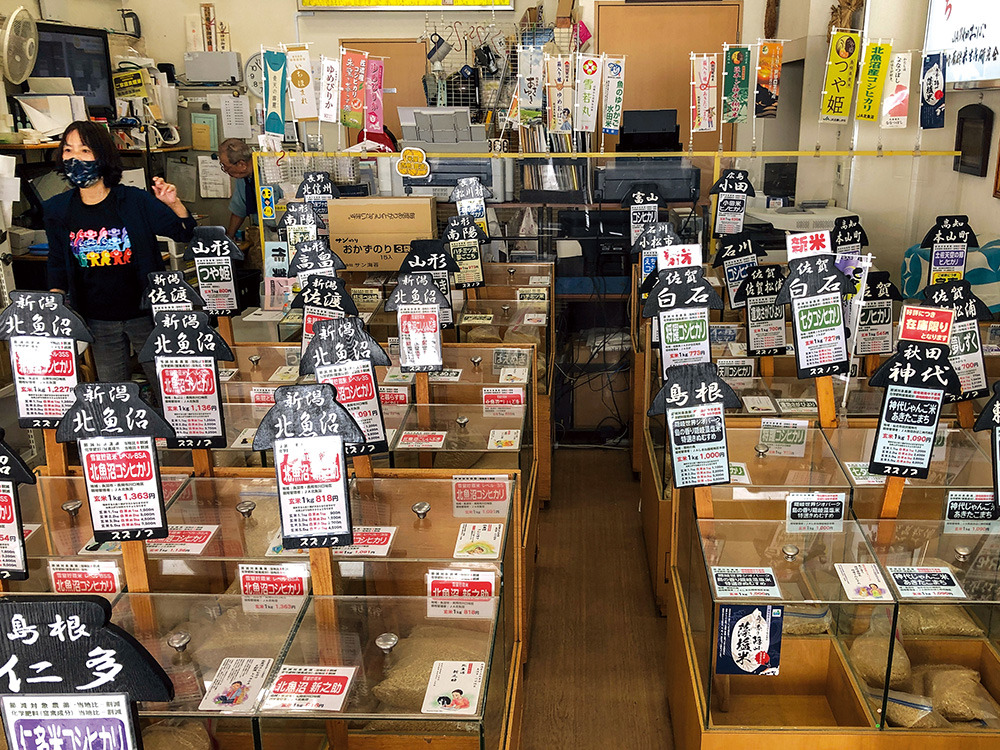
In his shop in Meguro, Tokyo, Nishijima Toyozo sells over 100 varieties of rice.
In any case, never use tap water because it spoils the taste. In the past, when I did my evaluations, I had to use commercially available mineral water for both cleaning and cooking rice. Luckily, there are much better purifiers now, which just filter the water; they remove chlorine while retaining the all-important minerals.”
You may be excused for feeling overwhelmed by the task of choosing rice among so many brands on display in Nishijima’s store. “First of all, you should tell the rice shop what you like. For example, do you like firm or soft rice?” he says, “Instead of choosing a famous brand such as Koshihikari, I think it’s better to look for something that suits your palate. If you aren’t aware of your preferred taste, try buying small quantities of various brands from Hokkaido to Kyushu.
“Many rice varieties are now produced throughout Japan, and the characteristics of each variety are explained in detail: stickiness, sweetness, aroma, etc. So it’s better to compare the rice produced in various different areas and find one that suits your taste. Also, if rice is produced near the sea, it goes well with seafood, and rice from the mountains pairs easily with mushrooms and edible wild plants.
“As a rule, local rice, i.e. rice grown near where you live, is always a good choice. Local rice goes well with local water and food, as it is commonly referred to as ‘local production for local consumption’. So if rice is grown in your area, you should definitely try it. By the way, the rice sold in supermarkets is milled in the area it was produced, distributed and then stored, so that when most of the rice reaches the shelves, it has been milled for more than a week, which is not good. When buying rice, choose one with a recent milling date.”
It’s said that brown rice is good for your health, but Nishijima thinks that does not mean you have to eat it every day. “For example, it’s better to avoid brown rice when you are not feeling well,” he says. “Instead of eating three meals of brown rice every day, by alternating it with white rice and noodles during the week, the intestines are activated by giving an appropriate amount of stimulation to the stomach, while brown rice helps excrete food.”
Storing rice is another delicate matter. “Rice is currently treated as a fresh food,” Nishijima says. “The freshness of rice will decrease within a week, so ideally freshly polished rice should be eaten in a short period of time. If you purchase a large amount of rice, divide it into small amounts and store it in the vegetable compartment of the refrigerator so that the rice hiber- nates and remains fresh for about three times longer. Storage at room temperature is not recommended. Japanese winters are especially dry, so the rice is prone to cracking, resulting in uneven cooking and a very poor texture.”
For Nishijima, rice is much more than just Japan’s staple food. “Nowadays, it’s natural that whatever brand you choose, the average quality is quite high. For this reason, consumers’ choices are often dictated by economic reasons: the cheaper the better. They don’t care about the variety or its place of origin. As a result, entire rice-producing areas fall into recession and young people leave the countryside. However, in order to reverse the situation, enterprising young producers have recently started to take a leading role in each region, and there’s an enthusiastic movement towards producing unique brands. I hope that rice will help rejuvenate different regions and revitalise the land. If enough young people discover the value of agriculture, I think it will strengthen the local community and lead to renewal.
“Rice is easy to store, easy to cook and an ideal energy source. It makes a lot of sense to use it as a staple food.”
Gianni Simone

